Shortcut: http://syke.fi/projects/nitros
Background
The strain of fur farms on the water system and on groundwater can be regionally and locally significant due to the intense centralization of animal breeding. In Finland there are approximately 50 fur farms located at classified aquifers important for water supply. In addition, there are approximately 80-100 closed fur farms on those aquifers. More specifically in Western Finland, there are 30 fur farms that pose a significant risk of contamination to important aquifers.
Rain and meltwater cause the nitrogen and phosphorous compounds in fur animal feces to leach into groundwater or via runoff to surface water bodies. In the important aquifers, the main problem is the rising levels of nitrate and nitrite. On the basis of the water framework directive given by the European Union, the Finnish ministry of social affairs and health has set the maximum concentrations of nitrate and nitrite in drinking water at 50 mg/l and 0.5 mg/l respectively. Moreover, other problems such as the leaching of drugs given to the fur animals may form a risk to the groundwater quality.
So far in the remediation of fur farm areas, only the top layers of the soil are removed. Nitrate infiltrates easily in the ground and into the saturated zone of the aquifer. Removing soil deep from the ground and transporting it elsewhere for decontamination would be very impractical and expensive. Added to that, removing soil from the unsaturated zone will not solve the contamination of groundwater itself.
Research objectives and methods
The aim of the project was to test and develop a biological in situ -method for remediating soil and groundwater at a fur farm that has been contaminated with nitrate.
The method is based on enhancing the activity of denitrifying bacteria that naturally occur in soil and groundwater. An easily degraded organic chemical is added to the soil and/or groundwater which the bacteria oxidize and simultaneously reduce nitrate to nitrogen gas.

|
|
Nitrification-denitrification process
|
First, organic nitrogen in the animal excrement is microbiologically decomposed and ammonia (NH4+) is formed. This degradation often happens on the top layer of the ground. In the soil, ammonium takes part in three processes: leaching, sorption and nitrification. Part of the ammonium is infiltrated to the saturated zone via rain and meltwater. Part of the ammonium adsorbs onto the surface of soil particles and forms a long-term ammonium reserve in the unsaturated zone. In the presence of oxygen, the nitrifying bacteria convert the ammonium via nitrite (NO2-) to nitrate (NO3-). In areas with permeable soil and a heavy load of organic nitrogen, high levels of ammonium, nitrate and nitrite can be found in groundwater. Because nitrification consumes oxygen and produces acidity, the groundwater is anoxic and acidified in such areas.
One can try to remove the nitrate and nitrite in the groundwater by stimulating the denitrification process. Denitrification, t is an anaerobic microbial process. Because the low amount of organic matter in the nitrate-contaminated groundwater is nearly without exception the limiting factor for denitrification, organic matter must be added to the groundwater as an energy source for the denitrifying bacteria.
NITROS-study consisted of three phases: Preliminary research, pilot-scale sand filter tests and full-scale field study.
In preliminary research (2004), ethanol, potassium formate, calcium-magnesium formate, sodium acetate and sodium lactate were tested for their applicability as the carbon source for the denitrifying bacteria. In laboratory tests, the effect of each chemical on the denitrification activity of soil samples taken from a fur farm was measured at different concentrations. The tests were performed at a temperature of 6 oC. Ethanol and sodium acetate were found to clearly enhance denitrification better than the other chemicals in the test. Ethanol stimulated denitrification on a wider concentration range than acetate.
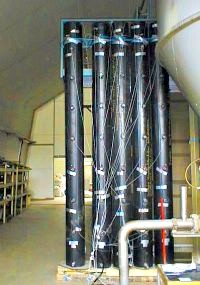
|
|
Sand filters before insulation
|
Sand filter tests 2005–2006. Two of the most promising chemicals (ethanol and acetate) were chosen for further testing, which began in
fall 2005 at Suomenoja research station. The pilot-scale study was performed in sand filters in order to simulate field conditions. The aim of the tests was to optimize the denitrification process in soil at low temperature (6 oC) by varying the amounts of ethanol and acetate. Water quality changes were analyzed from injected solutions and filtrates from different depths of the columns during the pilot test.
Both acetate and ethanol reached 95-100 % nitrate removal efficiency (initial nitrate level of 200 mg/l). The most optimal carbon:nitrogen ratio was between 6 and 10. Ethanol proved to be a more efficient denitrification stimulant than acetate, and in the ethanol columns less nitrite was formed than in the acetate columns.
Based on preliminary and pilot-scale studies, ethanol was chosen to be used as the carbon source in the full-scale field trial.
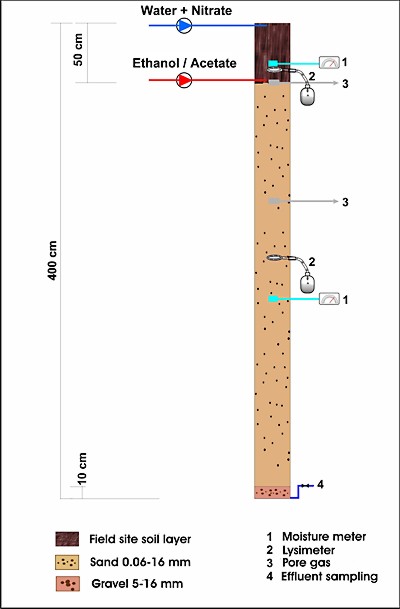
|
|
Pilot-scale sand filter
|

|
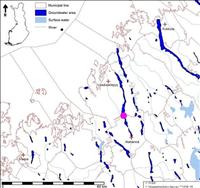
|
|
Location of the field site
|
Field studies 2005–2008. The field site was located at a small fur farm in Uusikaarlepyy. The research goals were: 1) to test, develop and optimize the method for denitirification in the field and 2) to find the boundary conditions and preconditions of successful bioremediation of nitrate contaminated groundwater. Furthermore, new information was produced on the true groundwater effects of fur farms.
Contamination occurrence and transportation were investigated in the first phase of the field study. Based on contaminant levels and a preliminary review of the groundwater flow, an infiltration system was built in order to introduce ethanol through the unsaturated zone to groundwater. During the field studies water containing denatured ethanol was injected into the soil in pulses. Ethanol infiltrations began in fall 2006 and continued until December 2008, except where snowfall was high during some parts of the winter.
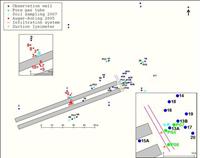
|
|
Field test arrangements at the study area
|
Various parameters were measured during the course of the study including groundwater temperature (4.2-7.4 oC), groundwater quality and pore gases measurements in the unsaturated zone. Also, the functionality of the method was investigated by chemical analyses of soil samples, measurements of stable isotopes, tests of denitrification potential and DNA studies.
Investigations at the field site
Installation of groundwater observation wells (2005, 2006 and 2008)
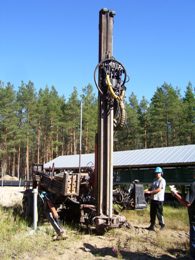
|
|
Installing observation well in the vicinity
of the open-sided animal sheds
|
Groundwater quality monitoring (2006–2008)
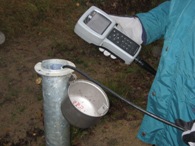
|
|
YSI-meter in use
|
Measurements of groundwater quality were performed at 0.5 m intervals in the observation wells. The temperature, dissolved oxygen, pH, electrical conductivity and redox potential of groundwater were measured with YSI556 field meter.
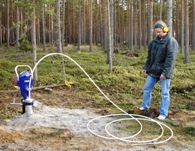
|
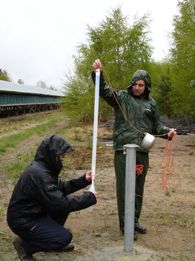
|
|
Stagnant water is pumped out of the observation well before groundwater sampling. A minimum of three times the volume of groundwater in the well is removed before sampling
|
Sampling groundwater with a bailer
|
Hydrogeological survey (2005–2008)
The hydraulic permeability of the groundwater zone was investigated by slug or recovery tests, which give an estimate of the average horizontal permeability in the vicinity of the sieve of the observation well. In the test a sudden change of groundwater level is caused by laying a cylinder in the observation well and monitoring the recovery of the water level.
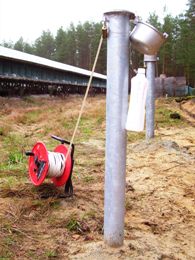
|

|
|
The latter phase of the recovery test: the cylinder has been removed from the well and groundwater levels are monitored both manually and by a datalogger (diver), which measures the water pressure continuously.
|
Cylinder used in the Slug-test
|
Soil sampling (2005–2008)
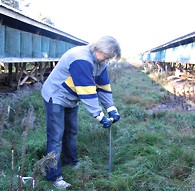
|
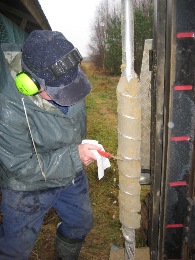
|
|
Soil sampling with manual Auger
|
Soil sampling with mechanical Auger
|
Carbon substrate infiltration to soil and optimizing the removal of nitrate (2006–2008)
The carbon substrate – ethanol – was infiltrated as a weak water solution into the unsaturated zone through the subsoil pipe system.
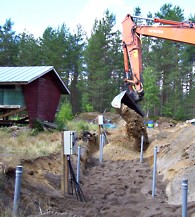
|
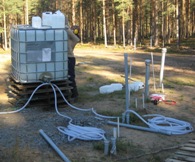
|
|
Installation of carbon substrate infiltration pipe system
|
Carbon source (ethanol) is diluted with water
|
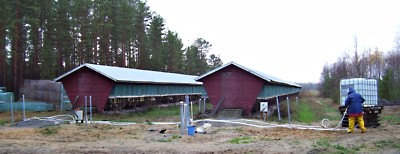
|
|
Carbon substrate infiltration in operation
|
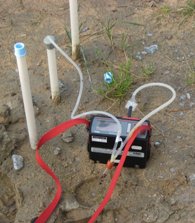
|
|
Sampling pore gas
|
Pore gas measurements (2006–2008)
The effects of ethanol infiltration on the proportions of oxygen and carbon dioxide in the pore volume of the unsaturated zone were detected with pore gas measurements. The degradation of ethanol consumes oxygen and increases the amount of carbon dioxide in the pores. Carbon dioxide is an end product of ethanol oxidation via denitrification.
Report (2009-2010)
Conclusions from the field study
- There were high concentrations of nitrate and ammonium in the soil and groundwater beneath the fur farm.
- Natural attenuation of groundwater contaminated with nitrogen compounds is insignificant without active remediation measures, because there is not enough organic matter available for the denitrifying bacteria in the soil and groundwater. For this reason, nitrogen compounds (ammonium and nitrate) occur in high concentrations in the soil and groundwater at fur farms.
- Nitrification is an acidifying process, consequently ammonium loaded groundwater becomes acidic. Acidification increases the dissolution of many heavy metals into groundwater. The concentrations of nickel and aluminum exceeded multifold the quality requirements (Ni 0.02 mg/l) and recommendations (Al 0,2 mg/l) of drinking water.
- Ethanol enhanced natural denitrification and the concentration of nitrate nitrogen in the treated groundwater decreased from the level preceding the field test (circa 30 – 60 mg/l) to 1 mg/l, which is notably below the Finnish water quality standard for drinking water (11 mg/lN which equals to 50 mg/l nitrate).
- In order to establish remediation results, one must use concurrent parameters, such as nitrate levels, nitrate-chloride proportions and potentially measurements of stable isotopes among other things.
- Infiltrating ethanol to the groundwater through a pipe system in the unsaturated zone is technically feasible, easy to use and inexpensive. Infiltration to the unsaturated soil did not clog the pipe system, which is more likely to happen when the carbon source is introduced directly into the groundwater.
- In order to optimize the remediation method, pH should be high enough and preferably > 5.5. Denitrification produces alkalinity and efficiently working denitrification, as well as removing nitrate, also decreases the metal content of acidic groundwater.
- Denitrification may not be efficient in the vicinity of the infiltration system, if the conditions are not optimal (e.g. too low a pH). An increase in nitrite concentration indicates the process is not functioning optimally. In the NITROS study, the zone in which the process was efficiently functioning was at a distance of 15-20 m from the infiltration field.
- Groundwater remediation by stimulating natural denitrification requires good knowledge of the water flow pattern and an adequate network of observation points for groundwater quality at the site.
Project organization
The collaborative research partners in the project were Finnish Environment Institute, West Finland Regional Environment Centre (nowadays: Centre for Economic Development, Transport and the Environment for South Ostrobothnia and Regional State Administrative Agency of Western and Inland Finland) and Pöyry Finland Oy.
Project was funded by Ministry of Environment, Kemira Oyj, Finnish Fur Breeders' Association and Maa- ja vesitekniikan tuki ry.
Main publications
Jani M. Salminen, Sanna J. Petäjäjärvi, Sirkku M. Tuominen & Taina H. Nystén. 2014. Ethanol-based in situ bioremediation of acidified, nitrate-contaminated groundwater. Water Research 63 (2014) 306–315
Jani Salminen, Sirkku Tuominen ja Taina Nystén. 2012. Biological in situ remediation of nitrate-contaminated soil and groundwater at fur farms. In Finnish with English summary.
(Nitraatilla pilaantuneen maaperän ja pohjaveden biologinen kunnostaminen turkistarha-alueilla)
Derek Martin, Jani M. Salminen, R. Maarit Niemi, Ilse M. Heiskanen, Matti J. Valve, Pasi P. Hellstén & Taina H. Nystén. 2009. Acetate and ethanol as potential enhancers of low temperature denitrification in soil contaminated by fur farms: A pilot-scale study. Journal of Hazardous Materials 163, 2009, 1230-1238
Research report (abstract in English): Sanna Petäjäjärvi, Taina Nystén, Jani Salminen & Sirkku Tuominen, 2010. Nitraatin poisto turkistarha-alueiden maaperästä ja pohjavedestä– Maastokoe Karkauskankaan pohjavesialueella
Further information
PhD, Head of Unit Jani Salminen, Finnish Environment Institute (SYKE)
firstname.surname@syke.fi
LicSc(Tech), Senior researcher Sirkku Tuominen, Finnish Environment Institute,
firstname.lastname@syke.fi
Project leader, PhD, Leading Expert Taina Nystén, Finnish Environment Institute,
firstname.lastname@syke.fi